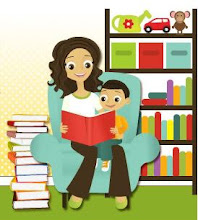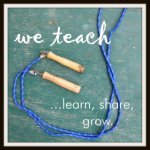I wrote the original post a few months back, but today, I saw an article from the Baltimore Sun about Disney refunding money because of accusations that the company may have overstated the educational benefits of Baby Einstein videos. This is another example of a product, in my opinion, that seeks to exploit a parent's desire to do what's best for their child. Is there anything wrong with making and selling these products? No, after all, this is a free country. Parents should be able to buy what they want for their child and if they want their toddler to watch these videos, then so be it (even though the American Academy of Pediatrics discourages TV for children under two). But parents should not be duped into thinking that these products offer a magic solution to teach their baby to read. The magic is in the parenting: Read, Talk, and Sing. THAT'S the magic!
Visit the
Campaign for a Commerical Free Childhood.
-------------------------------------------------
When I was first inundated with commercials posters, videos, and talk shows promoting these programs promising to teach babies to read, I hoped, no I
prayed, that this was just a passing fad like leg warmers or sea monkeys. The videos of little babies reading flashcards annoy me to no end. I know, I know...I proclaim to be an advocate of
early literacy. So why am I so agitated by these baby reading programs?
OK, here's the deal: I just think babies have more important stuff to learn. Exposing children to language and literacy in meaningful and relevant ways is what helps children become happy and effective readers; reading skills rarely come in a neatly packaged box tied with a bow.
The biggest problem I have with these programs is that I think they capitalize on a parent's desire to do the right thing. Parents want to raise smart babies and most of what these programs promise can be provided for FREE. One of these programs cost as much as $200!!! A parent who provides a literacy rich environment can probably achieve the same (or better) results without having to spend enormous amounts of money. It's like those credit repair companies who swear that they can repair your credit for the low cost of $199.99 but all they do is call your creditors, which you can do yourself for the
low cost of FREE.
The first five years of a child's life is a time of rapid brain growth and parents and teachers are right to take advantage of this period of wonder and amazement. But, what is the advantage of a baby who can read the word "dog" but can't point to a dog in a book, who has never seen a real dog? I'm just saying that it is about BALANCE and EXPERIENCES. Really...what is the rush? Do we stand a 4 month old up on his feet in an effort to make him "walk"? Because surely if he walks at 4 months old, he will be the
best walker in his class by the time he gets to kindergarten! Why do we have to rush children? Why do the wonders of infancy have to be punctuated with flashcards and DVDs?
Here are things that parents and early childhood educators can do to promote early literacy skills in young children
- Talk to your child. Sounds simple but many parents don't do it. Reading is nothing more than oral language written down so children need to have a solid sense of oral language. Talk about what is happening when you change her diaper. Describe all of the things you see on your walk. Talk. Talk. Talk.
- Read to your child. I know that this sounds like another no brainer. But it's a crucial step in learning to read. Reading to your child often is just part of the process. Read with emotion. Point to some of the words in the book to help children make the connection between written and spoken words. Choose books with interesting pictures, rhythmic texts, and predictable plots.
- Siiiinnnnggg.....sing a song. Music has been proven to have a positive effect on the ability to learn. Music exposes children to language, patterns, and rhythms all of which are related to reading!
- Visit the library or connect with friends to find new books. Look for books that are sturdy and durable (like board books) so that babies can touch, hold, and manipulate the books. Baby books can be expensive so visit the library or swap books with friends/neighbors!
- Recognize that children learn from repetition so even though you should look for new books often, never abandon the favorites because children will want to hear them over and over and over. Early strides towards reading start with some imitation and memorization so read those favorites often. Your baby will let you know what their favorites are!
- Point out words and letters in the environment when it is appropriate. If toddlers can recognize the McDonald's logo then we know that they can recognize other letters. They learned the McDonald's logo probably because they see it often or because the place has something that they enjoy. So use environmental print whenever the opportunity presents itself: the box of Cheerios on the breakfast table, the K on the K-Mart bag, headlines in the newspaper, etc... print is all around us and we don't have to pay $200 for the fancy packaging!
- Provide your child with rich and varied experiences. I suspect that at least part of the reason why these type of programs work is because they require parents to spend a certain amount of time providing planned experiences with their child. So, why not do that anyway without the fancy kit? Take a walk, join a play group, go to the zoo, blow bubbles, paint a picture, make a tent, do a puppet show, find wonders in the world!!!! Remember things that are old news to us (a lemon, a butterfly, an empty box) are NEW to babies and toddlers!!!!
- Remember that children are rapidly growing in all areas of development. It is important to expose your child to activities that will promote the overall growth: Social Development (do you really want a child who can read but doesn't know how to take turns or say please?), Physical Development (obesity is a huge problem among today's children. Learning to navigate the environment is important for infants and toddlers), and Problem Solving Skills (so, your toddler can read but can't figure out how to put together a three-piece puzzle) are important areas that parents and teachers must not ignore.
Do I think these teach your baby to read programs are harmful? I don't know. The American Academy of Pediatrics doesn't recommend TV for children under the age of two. Other studies link TV watching to disorders such as ADD and ADHD. I really don't think that parents who purchase these type of programs are plopping their children in front of a TV just for the heck of it. I know that any parent who spends $200 on an infant reading program is doing so because they believe it will benefit their child. I don't blame parents who want their parents to be ahead of the curve. As parents, we all want our children to excel. I am confidant that most of the money spent on these type of programs could be better spent doing things that really matter to your child... and I can guarantee that the things that matter most to your baby have nothing to do with flashcards and DVDs!
Reading is not a sprint. It's a long distance marathon.
 While you might not want to do an entire "Monster" theme for your preschool or kindergarten class, this is the time of the year when many youngsters might begin discussing monsters, bats and other scary things. Here are a few monster ideas you can use in your classroom from A to Z Teacher Stuff and Pre-Kinders.
While you might not want to do an entire "Monster" theme for your preschool or kindergarten class, this is the time of the year when many youngsters might begin discussing monsters, bats and other scary things. Here are a few monster ideas you can use in your classroom from A to Z Teacher Stuff and Pre-Kinders.







































